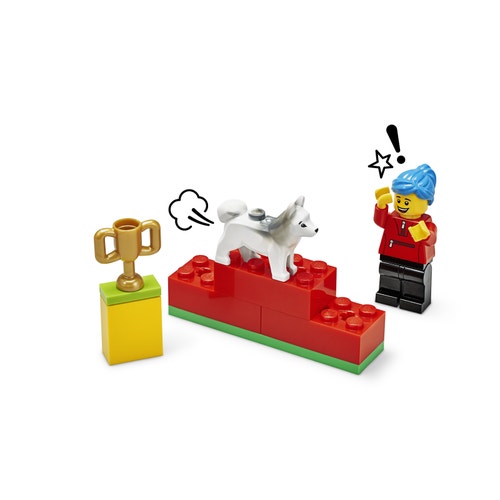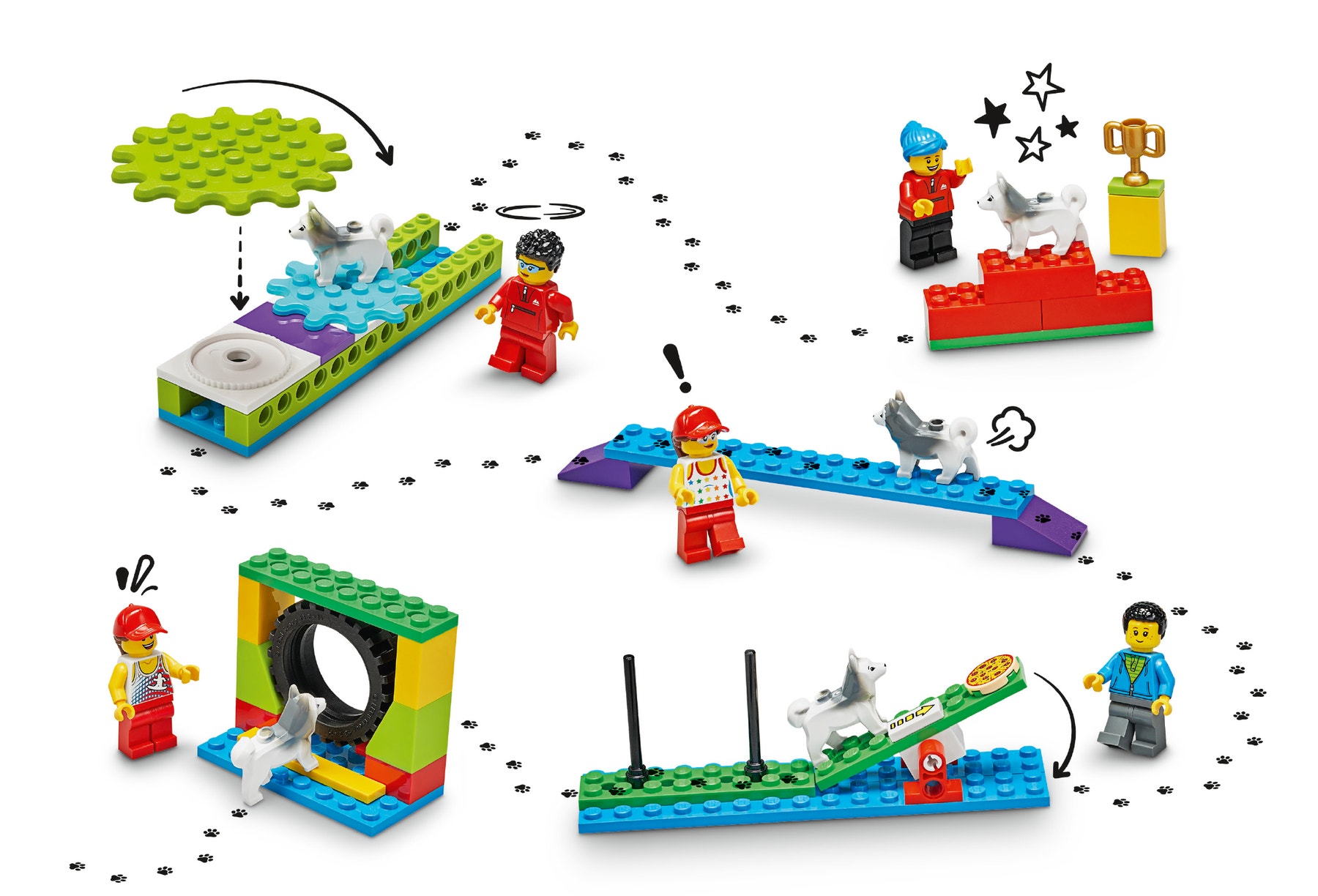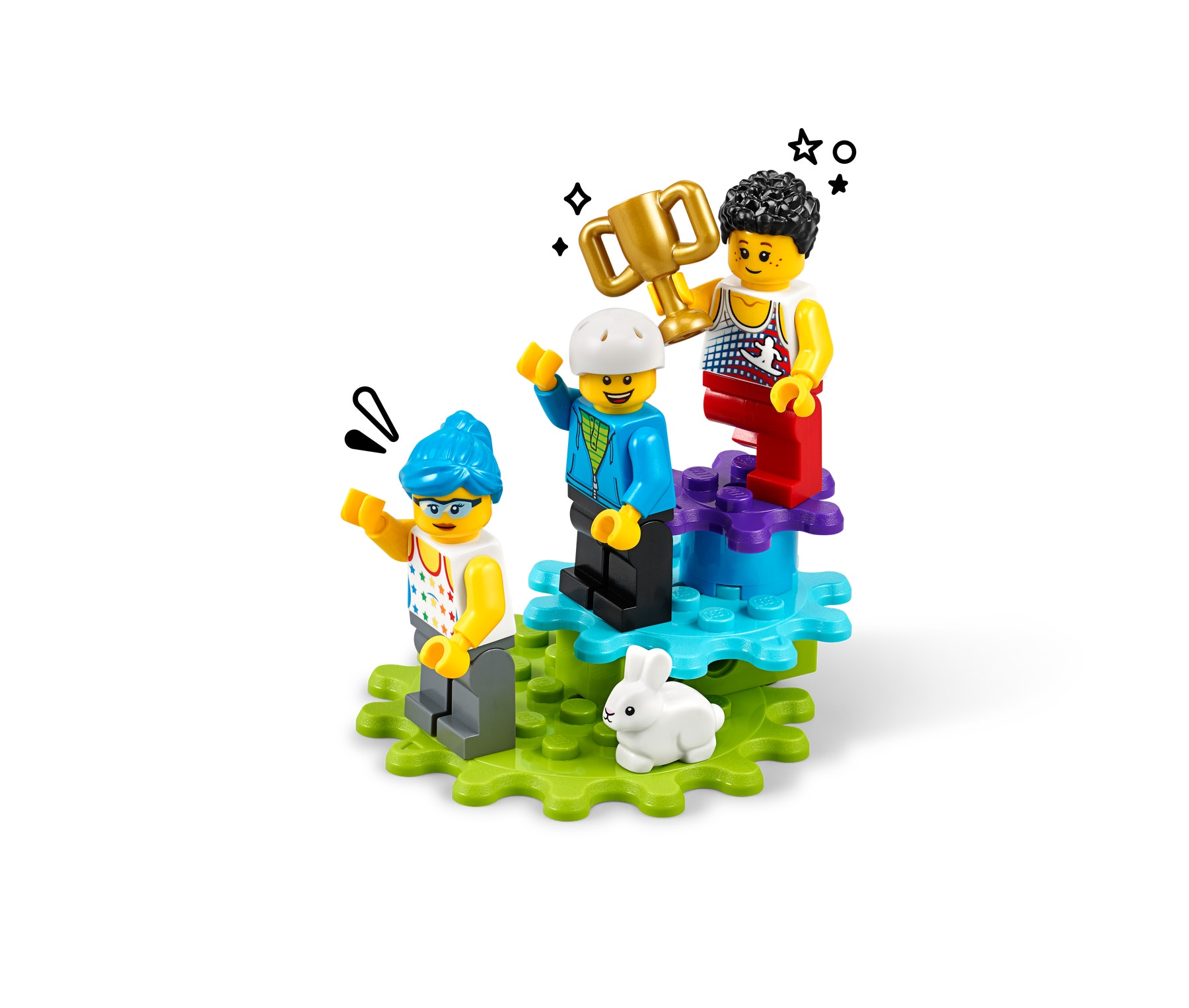Dog Obstacle Course
Build an obstacle course for dogs! Describe the push and pull forces that are at work. This lesson will help to familiarise your pupils with the contents of the LEGO® Education BricQ Motion Essential Set. We recommend taking some time before the lesson to show your pupils what is beneath the white tray, and to explain that the bricks are sorted by colour. The pupils will find the building instructions books under the tray. They will only need book ‘A’ for this unit.

Prepare
- Review the online pupil material. Use a projector to share this material with your pupils during the lesson.
- Make sure that you have covered the relevant concepts (i.e. push and pull) in an earlier lesson.
- Consider the abilities and backgrounds of all your pupils. Differentiate the lesson to make it accessible to everyone. See the Differentiation section below for suggestions.
Engage
(Whole Class, 10 Minutes)
- Watch the pupil video here or access it via the online pupil material.

- Facilitate a quick discussion about dogs.
- Ask questions like these:
- How do you train a dog?
- What types of training obstacles did you see in the video?
- How did the dogs react to them?
- Tell the pupils that they’re going to build an obstacle course for dogs. Explain that they will not be given building instructions but should instead use the picture on page 1 in their building instructions books to guide them. Explain that each group:
- Can copy the models that are shown in the picture on page 1 of building instructions book ‘A’, embellish them or invent their own designs.
- Should make at least 3 different types of obstacles for dogs to run through, over, under or around.
- Conclude the discussion by distributing a LEGO® Education BricQ Motion Essential Set to each group.
Explore
(Small Groups, 20 Minutes)
- Have the pupils work in pairs to design and build an obstacle course for dogs.
- There are not specific building instructions for this lesson. However, the pupils can refer to the picture on page 2 of building instructions book ‘A’ for inspiration. They are also welcome to design their own models.
- Note: There are not enough elements to build all the models in the inspiration picture at the same time.
- You can find building help in the Tips section below.
- Once the pupils have finished building, encourage them to line up their obstacles and run their dogs through the course.

Explain
(Whole Class, 5 Minutes)
- Gather your pupils together to share what they have built.
- Ask questions like these:
- How does the dog move through your obstacle course? (e.g. push/pull, up/down, over/under, through, across, around)
- Which obstacles require a push? (e.g. In the ‘fetch’ obstacle, you pull back the spring to push and launch the ball.)
- Which obstacles require pulling? (e.g. In the ‘dog sledge’ obstacle, where the dogs pull the sledge along.)
- Have you seen any other push and pull forces today?
Elaborate
(Whole Class, 10 Minutes)
- Have your pupils continue to invent and build more obstacles.
- If time permits, have the groups combine all their models to create a bigger obstacle course.
- Ask the pupils to disassemble their models, sort the bricks back into the trays and tidy up their workstations.
- Remind the pupils to check the floor for dropped elements and to put them back where they belong.
Evaluate
(Ongoing Throughout the Lesson)
- Ask guiding questions to encourage them to ‘think aloud’ and explain their thought processes and reasoning in the problem-solving decisions they have made when building their models.
Observation Checklist
- Measure your pupils’ proficiency in describing the push and pull forces that are at work in an obstacle course.
- Establish a scale that suits your needs. For example:
- Requires additional support
- Can work independently
- Can teach others
Self-Assessment
- Have each pupil choose the brick that they feel best represents their performance.
- Green: I think I can explain what ‘push’ and ‘pull’ mean.
- Blue: I know I can explain what ‘push’ and ‘pull’ mean.
- Purple: I can explain what ‘push’ and ‘pull’ mean, and I can help a friend to understand, too.
Peer Feedback
- In their small groups, have the pupils discuss their experiences working as a group.
- Encourage them to use statements like these:
- I liked it when you…
- I'd like to hear more about when you…

Tips
Model Tips
- The inspiration picture on page 2 of building instructions book ‘A’ shows 7 agility training models and 2 decorative models.
- Show your pupils how to use the Brick Separator to remove stuck bricks.

Differentiation
Simplify this lesson by:
- Assigning each group specific obstacles to build; the seesaw and round treadmill are great models to start with because these mechanisms emphasise pushing and pulling
Increase the difficulty by:
- Challenging the pupils to design even more training obstacles, including parts that move, spin, tilt, or roll
- For advanced builders, choose a random element and ask them to find a way to use it in a model
Extensions
Language Arts Extension (Note: This will require additional time)
To incorporate the development of language arts skills, have the pupils write an announcer’s script narrating their dog’s run through the obstacle course.
ACELY1661
Create short imaginative and informative texts that show emerging use of appropriate text structure, sentence-level grammar, word choice, spelling, punctuation and appropriate multimodal elements, for example illustrations and diagrams
1:1 Hybrid Learning
Download the Personal Learning Kit lesson plan from the hybrid learning resources.
Teacher Support
The pupils will:
- Become familiar with using this set to build models
- Explore how pushing and pulling affects an object's motion
- LEGO® Education BricQ Motion Essential Sets (one for every two pupils)
ACSSU003
Objects are made of materials that have observable properties
ACSHE013
Science involves observing, asking questions about, and describing changes in, objects and events
ACELY1661
Create short imaginative and informative texts that show emerging use of appropriate text structure, sentence-level grammar, word choice, spelling, punctuation and appropriate multimodal elements, for example illustrations and diagrams.




